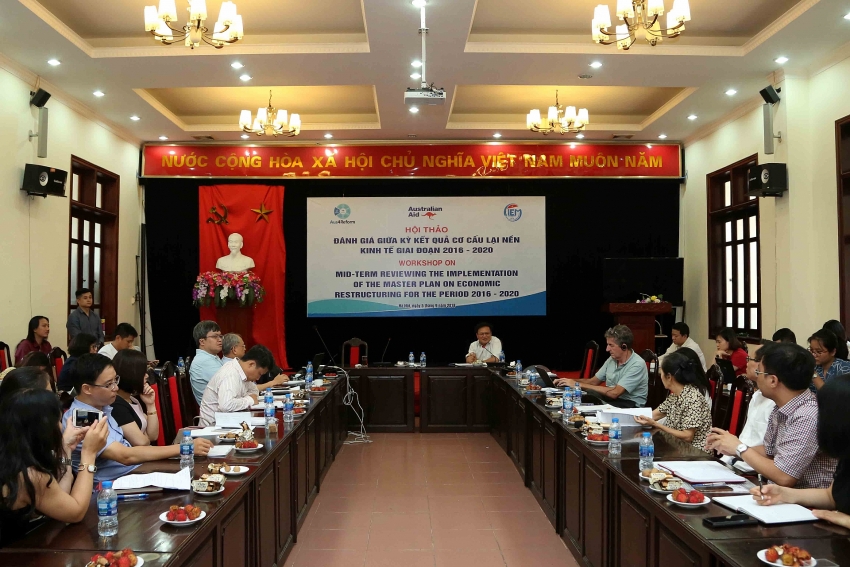Seeking a growth motivator for 2019-2020
 |
| The mid-term review of the implementation of the master plan on economic restructuring in 2016-2020 |
Economic growth on a decreasing trend
Resolution No.27/NQ-CP dated February 21, 2017 on the government’s action programme for implementing Resolution No.05-NQ/TW on major policies to renew growth models and improve the quality of growth, economic productivity, and competitiveness and Resolution No.24/2016/QH14 on the economic restructuring plan during 2016-2020 identified 16 directives and 120 concrete tasks.
The mid-term review of the implementation of the master plan on economic restructuring in 2016-2020 took place yesterday (September 5). Nguyen Dinh Cung, president of the Central Institute for Economic Management (CIEM), confirmed that most tasks previously set forth have been performed on schedule and produced positive results.
25.8 per cent of Resolution No.27/NQ-CP’s tasks have been carried out and brought the expected outcomes, while 57.5 per cent have been implemented but have yet to yield results, and 16.7 per cent are in development or are underway.
After two years of the implementation of the Resolution, 24 per cent of the targets have been completed, 32 per cent are possible to accomplish, and 41 per cent will be difficult to implement. For example, the average state investment into development projects has reduced to 11.9 per cent of the GDP in 2017 (from 12.4 per cent in 2016).
Regarding the initiative to restructurethe financial market, stock market capitalisation has been raised to 74.6 per cent of the GDP in 2017 from 43.2 per cent in 2016, higher than the 70 per cent target. Outstanding debts on the bond market were at 37.45 per cent of the GDP, while it was 27.3 per cent in 2016.
Industrial restructuring also produced good results. The proportion of the industry and construction sector make up 33.4 per cent of the GDP, and the growth of this sector has increased to 8 per cent in 2017, while GDP growth was 6.81 per cent.
However, resource allocation has not been altered to improve performance. The country has run out of motivations for growth, thus maintaining a high and sustainable growth rate would be very difficult, unless there are radical changes in people’s mindset, and the usage of state capital is made more effective, according to the report of the mid-term review.
The GDP growth of the last two years has been rather high. However, GDP growth in the second quarter (6.79 per cent) was lower than in the first quarter (7.45 per cent) of the year. “This is the first year when growth declines on-quarter. Does this signal a decreasing trend?” asked Nguyen Dinh Cung.
Seeking a new growth motivation
In order to improve the performance of the economy and seek a new motivation for growth, Nguyen Dinh Cung lauded fair market competition, which will be improved further through reducing anti-competitive behaviour at enterprises, cutting and reducing business conditions and the number of conditional business lines, as well as restructuring sectors exclusive to the state.
The competition will create technical, allocative, and dynamic efficiency, which will all improve economic efficiency to increase productivity and economic output, create more favourable conditions for investors, reduce the price of products and services, and create more jobs with higher salaries. These factors will form a dynamic and innovative economy with high growth.
Specifically, the restructuring of state-owned enterprises (SOEs) will concentrateon those with good performance and high return on equity (ROE) instead of projects and firms in the red, emphasised Cung. The revenue of Vietnam’s largest SOEs is very far from the lower ranking firms of the Global 500. Vietnam Electricity Group (EVN) gained $11.9 billion in 2017’s consolidated revenue, PetroVietnam $11.8 billion, Viettel $10.9 billion, Petrolimex $6.7 billion, Vietnam National Coal-Mineral Industries Holding Corporation Limited (TKV) $3.4 billion, while the revenue of Ericsson, the 500th-ranking company in the Global 500 was $23.5 million.
“We need to change the mindset and management methods of enterprises and SOEs in order to put Vietnamese companies into the Global 500,” noted Cung.
 |
| Nguyen Thuy Hien, deputy director general of the Ministry of Industry and Trade’s Department of Planning |
In order to improve the competitiveness of private industrial enterprises, deputy director general of the Ministry of Industry and Trade’s Department of Planning Nguyen Thuy Hien proposed to develop branded businesses in the region and over the world, as well as support small- and medium-sized enterprises (SMEs) to join the supply chains of transnational corporations and foreign-invested firms in Vietnam.
It is necessary to encourage big companies to do business in the automobile segment to rise on equal grounds with foreign-invested enterprises to develop this segment to meet domestic demand and contribute to socioeconomic development, emphasised Hien. Additionally, a project of strengthening technical standards and trade remedies also needs to be formulated to ensure an equal field of competition for domestic businesses.
What the stars mean:
★ Poor ★ ★ Promising ★★★ Good ★★★★ Very good ★★★★★ Exceptional
Related Contents
Latest News
More News
- State sector sees broad-based profit surge as major groups deliver strong results (January 13, 2026 | 17:34)
- HSBC forecasts Vietnam's GDP growth to hit 6.7 per cent in 2026 (January 13, 2026 | 17:33)
- Japfa maintains position in top 10 animal feed firms (January 13, 2026 | 10:18)
- Roadmap shaping up to phase out gas bikes (January 13, 2026 | 10:07)
- FDI momentum accelerates transformation of Vietnam’s plastics sector (January 11, 2026 | 07:00)
- UOB lifts Vietnam growth outlook to 7.5 per cent for 2026 (January 10, 2026 | 09:00)
- Exports cement role as central pillar (January 09, 2026 | 12:37)
- Siemens and NVIDIA expand partnership to build industrial AI operating system (January 09, 2026 | 10:04)
- High targets, hard choices: companies weigh risks in 2026 (January 08, 2026 | 16:58)
- Murphy Oil Corporation achieves appraisal success at Hai Su Vang oil field (January 08, 2026 | 11:35)

 Tag:
Tag:























 Mobile Version
Mobile Version